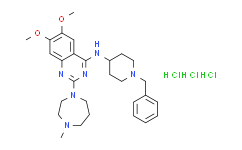| 中文名称: | BIX 01294 促销 | ||||
|---|---|---|---|---|---|
| 英文名称: | BIX 01294 | ||||
| 别名: | 2-(hexahydro-4-methyl-1H-1,4-diazepin-1-yl)-6,7-dimethoxy-N-[1-(phenylmethyl)-4-piperidinyl]-4-Quinazolinamine | ||||
| CAS No: | 1392399-03-9 | 分子式: | C28H38N6O2.3HCl | 分子量: | 600.02 |
| CAS No: | 1392399-03-9 | ||||
| 分子式: | C28H38N6O2.3HCl | ||||
| 分子量: | 600.02 | ||||
包装规格:
5mg 25mg 100mg in glass bottle
产品简介:
一种选择性的组蛋白甲基转移酶(HMTASE)抑制剂。
溶解性:
溶于水(>20 mg/mL)和DMSO(98 mg/mL)
储备液保存:
-80°C, 1 years
-20°C, 6 months
-20°C, 6 months
靶点:
IC50: 2.7 μM (G9a in DELFIA assay)
IC50: 1.9 μM for G9a and 0.7 μM for GLP
IC50: 1.9 μM for G9a and 0.7 μM for GLP
体外研究:
BIX-01294 (2 μM; 48 h) trihydrochloride selectively inhibits recurrent tumor cell growth.
BIX-01294 (1 μM) trihydrochloride leads to a marked increase in phosphorylation of S345 of MLKL.
BIX-01294 (1 μM) trihydrochloride significantly upregulates the canonical p53 targets Cdkn1a (p21) and Gadd45a in recurrent tumor cell lines.
BIX-01294 (1 μM; 6 days) trihydrochloride causes the reduction in H3K9me2 levels in primary and recurrent tumor cells.
BIX-01294 trihydrochloride leads to necroptotic cell death in recurrent tumor cells. Necrostatin-1 (30 μM) partially reverses cell death induced by BIX-01294 (750 nM; 24 h) trihydrochloride.
BIX-01294 (4.1 μM; for 2 days) trihydrochloride causes around a 20% reduction, concomitant with a comparable increase in the unmodified H3K9 fragment in H3K9me2 in mouse ES cells. BIX-01294 trihydrochloride causes pronounced reduction in H3K9me2 and a small decrease for H3K9me3 and H3K9me1 in wild-type ES cells.
BIX-01294 trihydrochloride has no inhibition of the other histone methyltransferases even at concentrations of 45 μM. BIX-01294 trihydrochloride does not affect SUV39H1 (H320R) and PRMT1 within the tested concentration range (up to 10 μM).
BIX-01294 trihydrochloride inhibits G9a in an uncompetitive manner with S-adenosyl-methionine (SAM).
BIX-01294 (1 µg/mL) causes reduction in the BrdU incorporation of fetal PASMCs. BIX-01294 treatment decreases the PASMCs migration induced by PDGF.
BIX-01294 (1 μM) trihydrochloride leads to a marked increase in phosphorylation of S345 of MLKL.
BIX-01294 (1 μM) trihydrochloride significantly upregulates the canonical p53 targets Cdkn1a (p21) and Gadd45a in recurrent tumor cell lines.
BIX-01294 (1 μM; 6 days) trihydrochloride causes the reduction in H3K9me2 levels in primary and recurrent tumor cells.
BIX-01294 trihydrochloride leads to necroptotic cell death in recurrent tumor cells. Necrostatin-1 (30 μM) partially reverses cell death induced by BIX-01294 (750 nM; 24 h) trihydrochloride.
BIX-01294 (4.1 μM; for 2 days) trihydrochloride causes around a 20% reduction, concomitant with a comparable increase in the unmodified H3K9 fragment in H3K9me2 in mouse ES cells. BIX-01294 trihydrochloride causes pronounced reduction in H3K9me2 and a small decrease for H3K9me3 and H3K9me1 in wild-type ES cells.
BIX-01294 trihydrochloride has no inhibition of the other histone methyltransferases even at concentrations of 45 μM. BIX-01294 trihydrochloride does not affect SUV39H1 (H320R) and PRMT1 within the tested concentration range (up to 10 μM).
BIX-01294 trihydrochloride inhibits G9a in an uncompetitive manner with S-adenosyl-methionine (SAM).
BIX-01294 (1 µg/mL) causes reduction in the BrdU incorporation of fetal PASMCs. BIX-01294 treatment decreases the PASMCs migration induced by PDGF.
体内研究:
BIX-01294 trihydrochloride (10 mg/kg; IP; three times a week for 2 weeks) significantly reduces tumor growth and tumor burden in recurrent tumor cells. Primary tumor growth is not inhibited.
激酶实验:
HMTase实验:
在涂有Neutravidin的白色不透明384孔板中进行解离增强镧系荧光免疫分析(DELFIA)。实验化合物在含4% DMSO的12 μg/ml 50mM Tris-HCl pH 8.5中稀释,每孔分配10 μl。空白和对照孔只有化合物缓冲液。10 μg/ml GST-G9a和40 μM SAM在50mM Tris HCl pH 8.5/10 mM DTT 中稀释,然后加入20 μL。空白孔只有Tris/DTT缓冲液。加入溶于50 mM Tris pH 8.5,体积为10 μl的800 nM H3(1-20)-cysbiotin 底物,开始反应,在室温下温育60分钟。使用100 μl 洗涤缓冲液洗涤实验板3次。然后实验板的每孔中加入含5ng α-2X-二甲基-H3-K9 和 5ng 山羊抗兔Eu螯合物的50 μl 荧光免疫(FI) 缓冲液,在室温下再温育1小时。使用100 μl洗涤缓冲液 洗涤实验板3次,每孔加入50 μl增强液。45分钟后在Viewlux微孔板成像仪成像15秒,测量时间分辨荧光。
在涂有Neutravidin的白色不透明384孔板中进行解离增强镧系荧光免疫分析(DELFIA)。实验化合物在含4% DMSO的12 μg/ml 50mM Tris-HCl pH 8.5中稀释,每孔分配10 μl。空白和对照孔只有化合物缓冲液。10 μg/ml GST-G9a和40 μM SAM在50mM Tris HCl pH 8.5/10 mM DTT 中稀释,然后加入20 μL。空白孔只有Tris/DTT缓冲液。加入溶于50 mM Tris pH 8.5,体积为10 μl的800 nM H3(1-20)-cysbiotin 底物,开始反应,在室温下温育60分钟。使用100 μl 洗涤缓冲液洗涤实验板3次。然后实验板的每孔中加入含5ng α-2X-二甲基-H3-K9 和 5ng 山羊抗兔Eu螯合物的50 μl 荧光免疫(FI) 缓冲液,在室温下再温育1小时。使用100 μl洗涤缓冲液 洗涤实验板3次,每孔加入50 μl增强液。45分钟后在Viewlux微孔板成像仪成像15秒,测量时间分辨荧光。
保存条件:
-20℃
注意事项:
1、为了您的安全和健康,请穿实验服并戴一次性手套操作。
2、以上信息仅做参考交流之用。
2、以上信息仅做参考交流之用。
UN码:
HazardClass:
危害声明:
安全说明:
搜索质检报告(COA)
参考文献 & 客户发表文献
本计算器可帮助您计算出特定溶液中溶质的质量、溶液浓度和体积之间的关系,公式为:
质量 (g) = 浓度 (mol/L) x 体积 (L) x 分子量 (g/mol)
摩尔浓度计算公式
用本工具协助配置特定浓度的溶液,使用的计算公式为:
开始浓度 x 开始体积 = 最终浓度 x 最终体积
稀释公式
稀释公式一般简略地表示为:C1V1 = C2V2 ( 输入 输出 )









